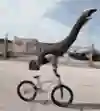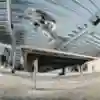Bike

BMX
Be spellbound by the unique talents of BMX freestyler Tim Knoll
One of the most creative BMX riders in the world showcases his talents with a new video section as he takes his unique riding style to the streets of his hometown of Milwaukee in the United States.
Tim Knoll's incredible style of street riding has turned heads since he hit the consciousness of the BMX community at the start of this decade. Knoll has since gone on to develop his riding to new levels and has evolved a style that mixes up BMX street and Flatland skills with acrobatics and gymnastics moves.
We saw the progression of Knoll's skills when he visited Berlin in 2016 and now two years on he's back with a new clip on familiar ground for him, his home streets of Milwaukee in the United States. Watch Knoll let loose in some backyard spots in the city in the video above.
We caught up with Tim at home in Milwaukee:
Where are you from?
Tim Knoll: I spent my early childhood in Downers Grove, a suburb of Chicago, Illinois. When I was six years old I moved to Wauwatosa, a suburb of Milwaukee, Wisconsin. I’ve remained in the Milwaukee area ever since.
What got you into riding BMX?
TK: Around the time I was seven years old in 1992, my older brother and I befriended a kid from the neighbourhood who was into BMX. I credit this kid, Nathan, with sparking my interest. He rode an old Redline with some rear pegs – I thought it was the coolest thing ever. Around that time I was watching Nickelodeon and I saw a video clip of a guy doing whiplashes (forward rolling tailwhips). That blew my mind. That was a great introduction to the possibilities of what can be done on a bike with pegs. Sometime thereafter I started learning bunny hops, and quasi endos where I’d hop my rear wheel off the ground while slowly traveling forwards.
What was the first trick that you learnt and how long did it take to get it dialled?
TK: Besides those early basic tricks I learned as a younger kid, the first legit flatland trick I learned was a rear wheel pogo. I had it dialled within a few days.
Rocking up at a skatepark or street spot can sometimes be super intimidating when you’re just starting out, what advice would you give to complete beginners that want to get into BMX?
TK: Always start small and build up. For instance, become comfortable with bunny hopping off a curb before hopping off a half metre ledge. Similarly, start by jumping a small wedge before trying to launch over a box jump. Tricks come with more experience and progression. Be patient. Skill takes time to develop.
Have you always ridden freestyle BMX?
TK: Freestyle BMX is the broad term for trick riding done on a BMX bike. As things evolved over time, freestyle BMX became more defined in terms of specific disciplines; street, park, vert, dirt and flatland. When I became really serious about BMX, I was 15 years old and at that point I was solely dedicated to riding flatland. After riding flatland for eight years I started working on basic street riding skills that I could combine with my flatland skills to do tricks that were truly freestyle. I broke from the confines of the individual disciplines to do what is more of the essence of freestyle BMX – doing cool things on my bike without limitations.
As a youngster you were a gymnast and a diver, what level were you at and do you think the strength and flexibility these disciplines require has helped you in BMX?
TK: By the time I quit gymnastics I was 13 years old. At that point I finished the 1998 season competing in level 4 and I was advancing to level 3, which is currently equivalent to level 8, just before I quit. I started diving in high school and I was a Wisconsin state qualifier for freshman, sophomore and junior year. I started riding flatland right before my sophomore year and my motivation to dive significantly diminished. I quit diving before the season started during my senior year so I could have more time to ride my bike.
My involvement in gymnastics and diving gave me a great acrobatic foundation to infuse into my riding style. Those skills definitely helped me to learn tricks that involve flipping, rolling, or doing handstands.
You’re one of the most creative BMX riders out there, what drives and inspires you?
TK: Thank you, I really appreciate that compliment. I’m inspired by other riders with unique styles. I especially like flatland from the '80s and '90s – some of my favourite riding came out of those eras. Aside from watching BMX videos, I also turn to skate and parkour videos for entertainment and motivation. I’m the type of person who thrives on physical activity; that’s generally what has kept me going.









